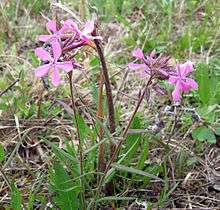Phlox pilosa
| Phlox pilosa | |
|---|---|
 | |
| Scientific classification | |
| Kingdom: | Plantae |
| (unranked): | Angiosperms |
| (unranked): | Eudicots |
| (unranked): | Asterids |
| Order: | Ericales |
| Family: | Polemoniaceae |
| Genus: | Phlox |
| Species: | P. pilosa |
| Binomial name | |
| Phlox pilosa L. | |
Phlox pilosa (downy phlox or prairie phlox) is an herbaceous perennial in the family Polemoniaceae. It is native to North America.
Description
Downy phlox grows 6–24 in (15–61 cm) high. The stems are upright and sometimes branched near the top. Leaves, stems, and sepals are covered with hairs and the plant is sticky to the touch. Leaves are long and narrow and have pointed tips; they can be up to 3 in (8 cm) long and 1⁄8–1⁄2 in (3–13 mm) wide. The flowers grow in rounded clusters up to 3 in (8 cm) at the top of stems. The flower stems have opposite leaves. Each flower has five lobes (petals) that are pale pink, lavender, or purple, and is 1⁄2–3⁄4 in (13–19 mm) across.[1][2]
 A clump of downy phlox
A clump of downy phlox Downy phlox and prairie dock (Silphium terebinthinaceum) in a Wisconsin prairie
Downy phlox and prairie dock (Silphium terebinthinaceum) in a Wisconsin prairie
Ecology
The flowers produce pollen on anthers near the end of the corolla tube, and nectar at the bottom of the corolla. Only butterflies, moths, skippers, and very long-tongued bees (the largest bumblebees) have long enough tongues to reach the nectar. Shorter-tongued bees and flower flies visit to feed on or gather pollen.[3]
The flowers are self-incompatible. Unless they are cross-pollinated, they will not produce any seed. Butterflies, skippers, and moths are the most effective pollinators. As they insert their proboscis into the corolla tube, it touches the anthers and picks up pollen. When they roll up their proboscis and move to the next flower, some pollen remains and is transferred to the stigma as they insert their proboscis into the next flower.[3]
References
| Wikimedia Commons has media related to Phlox pilosa. |
- ↑ Minnesota Wildflowers profile
- ↑ Ajilvsgi, Geyata. Wildflowers of Texas. Fredricksburg, Texas: Shearer Publishing, 1991. ISBN 0-940672-46-4
- 1 2 Heather Holm (2014). Pollinators on Native Plants. Minnetonka, MN: Pollinator Press. pp. 108–109.
"Phlox pilosa". Integrated Taxonomic Information System. Retrieved June 10, 2007.
External links
- Germplasm Resources Information Network (GRIN)
- USDA PLANTS Profile
- Native Plant Identification Network (NPIN)
- Missouri Botanical Garden
- Illinois Wildflowers
- Missouri Plants
- Minnesota Wildflowers
